

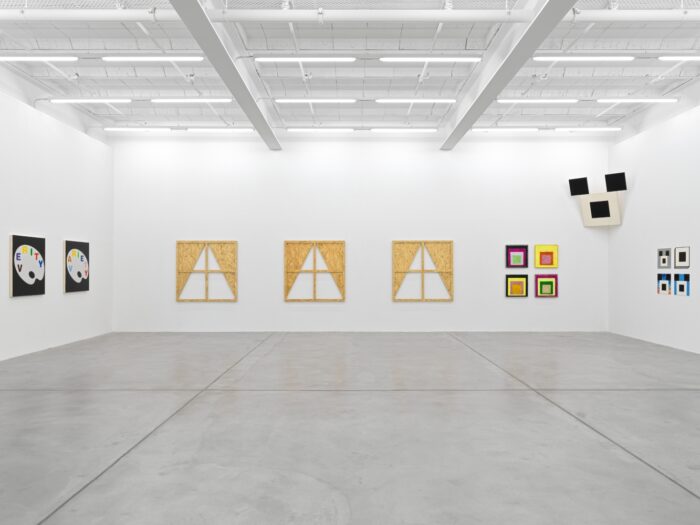
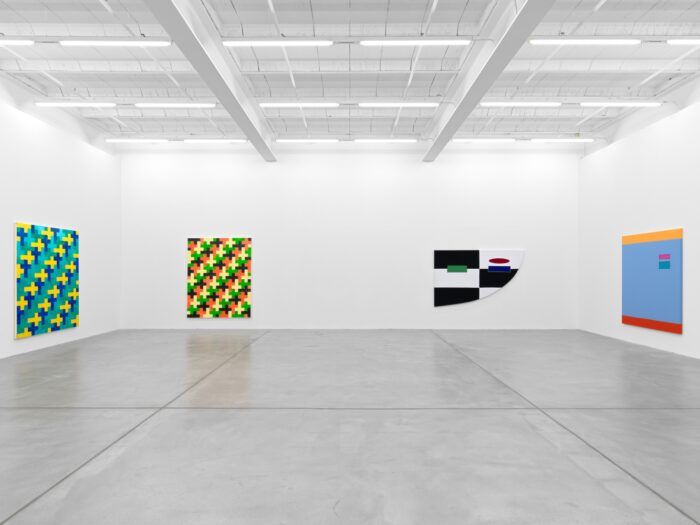
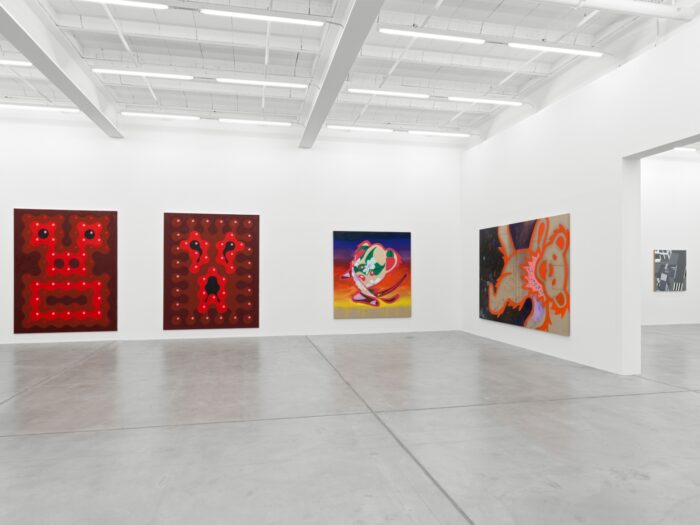
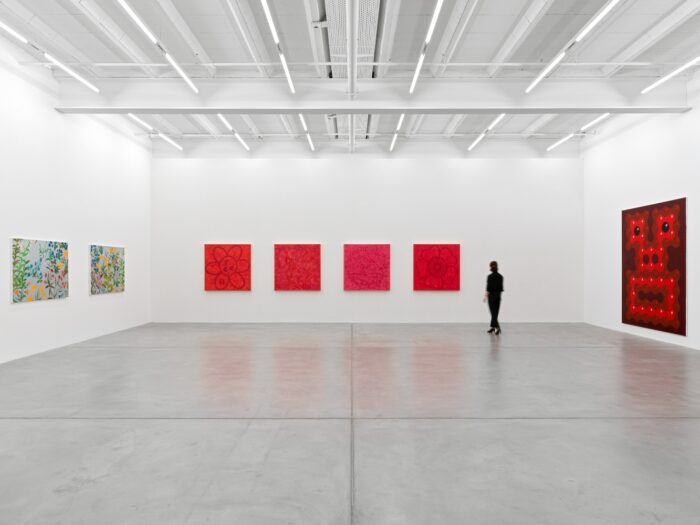
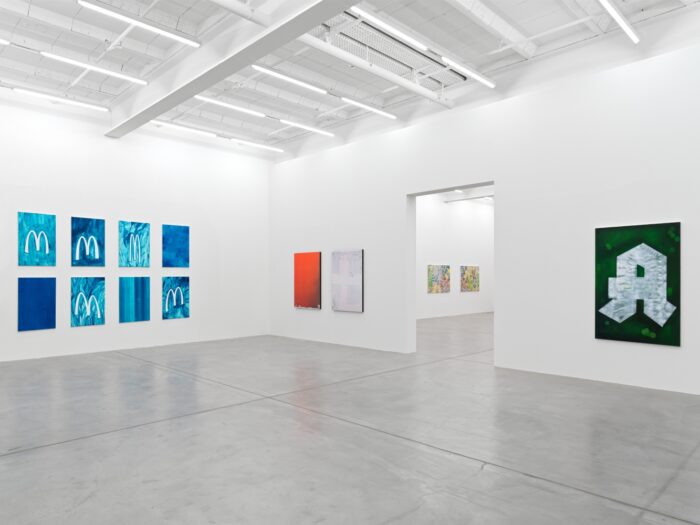


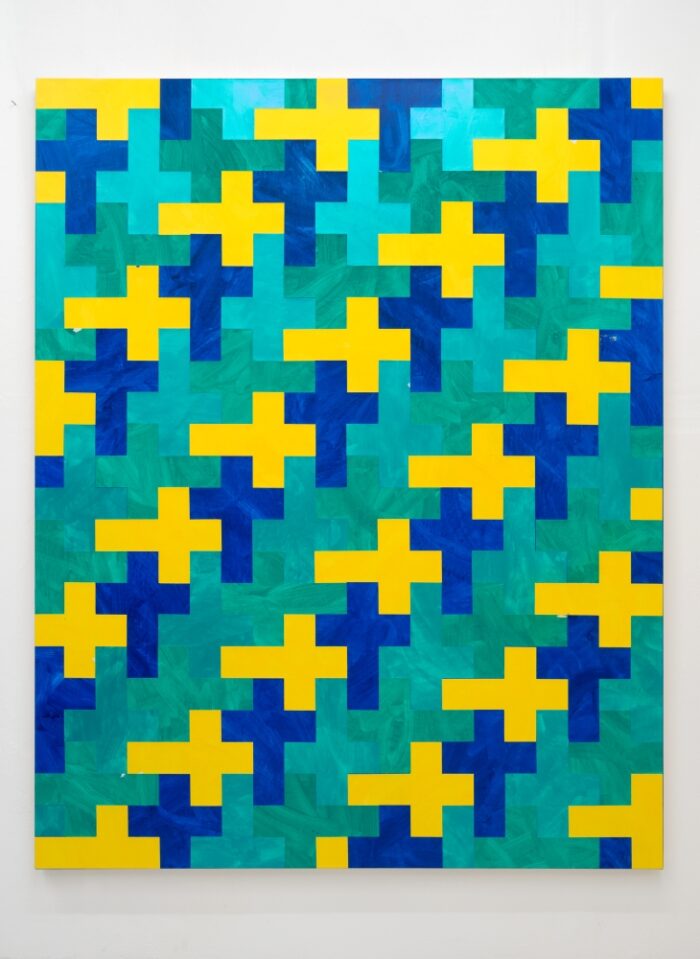



Paint-by-Numbers at Galerie Eva Presenhuber, Zurich
April 23 – May 28, 2022
All images courtesy of Galerie Eva Presenhuber
Mitchell Anderson, Tina Braegger, Anton Bruhin, Othmar Farré, Gina Fischli, Annamarie Ho, Damien Juillard, Tobias Kaspar, Jan Kiefer, Laura Langer
Galerie Eva Presenhuber is pleased to present Paint-by-Numbers, a group exhibition curated by Gianni Jetzer.
Paint-by-Numbers is an exhibition that revolves around contemporary artists who take a conceptual approach to painting, often following non-established production methods such as painting with industrial fabrics, logotypes, graphic designs, the cross, LEGO bricks, smartphones, borrowed motifs, or simply an empty stretcher bar, thus raising the question: How can you hone painting down to its bare conceptual bones while keeping it pertinent?
In 1962, Andy Warhol introduced a series of paintings based on the famous DIY art kit Paint-by-Numbers. Thereby he was countering the predominant style of abstract expressionism and its adoration of highly subjective gestures. Warhol’s conceptual approach, by contrast, was detached, calculating, but painterly nonetheless.
Sixty years after Warhol’s brainchild, and when figurative painting is in high demand, the group show Paint-by-Numbers gathers contemporary artists who follow Warhol’s legacy by painting from a conceptual angle and following instructions, resulting in the use of painting as a sheer vehicle. Applying multiple styles in parallel, often confounding abstraction and figuration, these artists reveal a penchant for appropriation and mimicry when impasto or brushstrokes are staged as a mere quotation of the look of painting.
The show is structured in three loosely assembled, partially overlapping chapters. The first one contains historical references from Anton Bruhin’s Suprematist Mickey Mouse to Blinky Palermo’s afterimages in the fabric assemblages of Annamarie Ho. The second chapter investigates standardization and staged reality where children’s toys and corporate identity meet. While in the last one, flowers are the guiding theme, an image motif that has been a popular stand-in in contemporary painting for decades.
Gianni Jetzer, Curator
Mitchell Anderson (born 1985 in Chicago, IL, US) uses existing objects and imagery in a body of work that explores contemporary and historical contradictions, humor, and tragedies of existence. In a broad multi-media practice, Anderson presents contemplative objects of collective hope and failure and questions the narrative capabilities and codes of the visual and physical.
Tina Braegger (born 1985 in Lucerne, CH) paints variations of large-scale Grateful Dead bears in oil on canvas. The psychedelic bear is the unofficial logo of the ’60s rock band The Grateful Dead. Her practice operates at the interference of the concept of her work in general and the quality of each single piece.
Since 1968, artist and musician Anton Bruhin’s (born 1949 in Lachen, CH) modes of expression have ranged from painting and drawing to palindromes and the jaw harp. Bruhin’s painterly oeuvre explores our collective visual language through its reduction to elementary anthropomorphic forms.
Othmar Farré (born 1985 in Brig, CH) treats art-making as a material and social process. His playful approach to production actively embraces the dialogic and performative aspects of perception and interpretation. His multilayered works remind us of the inescapable subjectivity through which we all must navigate (our) realities and the inherent fragility, humor, and absurdity contained within them.
In creating her own version of Josef Albers’ famous series, Gina Fischli (born 1989 in Zurich, CH) offers a camp antithesis to the Bauhaus intention in her material choices. By appropriating these iconic works in glitter, the artist turns the image against its modernist heritage.
Annamarie Ho’s (born 1980 in San Diego, CA, US) practice examines a diverse range of subjects—such as Formula One racing suits, hardware store merchandise, iconic designer chairs, and YouTube videos—which are all products of capitalist consumer culture. The resulting objects and videos intertwine her research into the commercialization of desire with formal compositional exploration that frequently draws from the language of art-historical references.
Damien Juillard (born 1996 in Geneva, CH) uses images, painting, print, and photography in his work centered around the representation of the human body, its absence, fragility, pleasures, and desires. Working on multiple digital and analog surfaces, Juillard presents compositions and images that originate from individual and collective experiences and that reflect how technologies filter bodily sensations, influence our gaze, and accentuate distance and fragmentation.
The paintings in Tobias Kaspar’s (born 1984, lives in Riga, LV, and Zurich, CH) Artists Pants series consist of textile patterns painted and printed over product images of designer garments taken from online fashion retailers, specifically clothing that mimics artists’ studio wear. The silkscreen studio used by the artist is involved in the textile production for Parisian fashion houses, which allows Kaspar to use the same resources as designers to create a perfect production loop between fashion and art and fashion: a snake biting its own tail.
Painting is often discussed as an artifact of modernity and, therefore, often regarded as a traditional object of the commercial market rather than as a potential source of aesthetic change. Jan Kiefer (born 1979 in Trier, DE) refers to this aspect by pointing out the positive relationship between the history of images with actualizing social values.
Laura Langer (born 1986 in Buenos Aires, AR) draws from their own photographic archive as a point of departure to create installations and paintings. The works speak to feelings and structures of the psyche, fears, desires, and identity through symbolic images and how they operate within the exhibition space.
